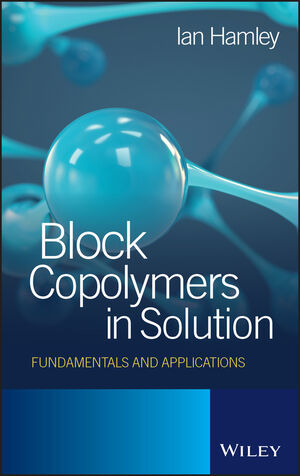Block Copolymers in Solution: Fundamentals and ApplicationsISBN: 978-0-470-01557-5
Hardcover
320 pages
September 2005
 |
||||||
Preface xi
1. Introduction 1
References 5
2. Neutral Block Copolymers in Dilute Solution 7
2.1 Introduction 7
2.2 Techniques for Studying Micellization 7
2.2.1 Cryo-TEM 7
2.2.2 Differential Scanning Calorimetry 8
2.2.3 Dynamic Light Scattering 8
2.2.4 Ellipsometry 10
2.2.5 Fluorescence Probe Experiments 10
2.2.6 Nuclear Magnetic Resonance 10
2.2.7 Rheology 11
2.2.8 Scanning Probe Microscopy 11
2.2.9 Small-angle X-ray and Neutron Scattering 12
2.2.10 Static Light Scattering 14
2.2.11 Surface Pressure–Area Isotherms 16
2.2.12 Surface Tensiometry 16
2.2.13 Viscometry 17
2.2.14 X-ray and Neutron Reflectivity 17
2.3 Micellization in PEO-based Block Copolymers 18
2.4 Micellization in Styrenic Block Copolymers 20
2.5 Determination of cmc 20
2.6 Thermodynamics of Micellization 22
2.6.1 Chain Length Dependence of Micellization 25
2.6.2 Effect of Architecture 27
2.6.3 Effect of Solvents and Salts on Micellization 32
2.7 Micellization and Micelle Dimensions: Theory and Simulation 33
2.7.1 Scaling Models 33
2.7.2 The Brush Model 37
2.7.3 The Self-consistent Mean Field Theory 40
2.7.4 The Model of Nagarajan and Ganesh 43
2.7.5 Computer Simulations 44
2.7.6 Theory: ABC Triblock Micelles 45
2.8 Micelle Dimensions: Comparison Between Experiment and Theory 47
2.9 Interaction between Micelles 51
2.10 Dynamics of Micellization 52
2.11 Dynamic Modes 56
2.12 Specific Types of Micelles 60
2.12.1 Micelles from Telechelics 60
2.12.2 Micelles from ABC Triblocks 62
2.12.3 Micelles from Rod–Coil Copolymers 66
2.12.4 Cross-linked Micelles 68
2.12.5 Janus Micelles 71
2.12.6 Nonspherical Micelles 71
2.12.7 Micelles Formed due to Specific Interactions 74
2.13 Micellization in Mixed Solvents 75
2.14 Mixed Micelles 75
2.15 Block Copolymer/Surfactant Complexes 76
2.16 Complex Morphologies 79
2.17 Vesicles 83
2.18 Crystallization in Micelles 90
References 91
3. Concentrated Solutions 105
3.1 Understanding Phase Diagrams 105
3.2 Phase Behaviour of PEO-containing Block Copolymers 111
3.3 Gelation 117
3.3.1 Rheology 117
3.3.2 Structure – Packing of Micelles 124
3.3.3 Thermodynamics of Gelation and Micellization in Concentrated Solution 126
3.3.4 Effect of Added Homopolymer, Salt or Surfactant 127
3.3.5 Influence of Architecture 129
3.4 Order–Disorder Phase Transition 132
3.5 Order–Order Phase Transitions 135
3.5.1 Structural Aspects 135
3.5.2 Ordering Kinetics 139
3.6 Domain Spacing Scaling, and Solvent Distribution Profiles 140
3.7 Semidilute Block Copolymer Solution Theory 143
3.8 Theoretical Understanding of Phase Diagrams 146
3.9 Flow Alignment 149
3.9.1 Lamellar Phase 149
3.9.2 Hexagonal Phase 151
3.9.3 Cubic Micellar Phases 152
3.10 Dynamics 159
3.10.1 Dynamic Modes 159
3.10.2 Dynamics of Gelation 160
References 164
4. Polyelectrolyte Block Copolymers 173
4.1 Micellization 173
4.1.1 General Remarks 173
4.1.2 Micellization in Block Copolymers Containing Anionic Blocks 175
4.1.3 Micellization in Block Copolymers Containing Cationic Blocks 179
4.1.4 Micellization of Polyampholyte Block Copolymers 182
4.1.5 Micellization of Polyelectrolyte-containing ABC triblocks 182
4.1.6 Micellization of Block Copolymers Containing Grafted Polyelectrolytes 183
4.1.7 Micellization in Block Copolymers Containing Sulfonated Polyisoprene 183
4.2 Chain Conformation 184
4.3 Theory 188
4.4 Polyion Complexes 195
4.5 Copolymer–Surfactant Complexes 198
4.6 Complexation with other Molecules 199
4.7 Gelation 200
4.8 Hierarchical Order in Peptide Block Copolyelectrolyte Solutions 200
4.8.1 α Helix Structures 202
4.8.2 β Sheet Structures 204
4.8.3 Hydrogels 206
4.8.4 Polypeptide Block Copolymer-based Complexes 207
References 208
5. Adsorption 215
5.1 Introduction 215
5.2 Adsorption at the Air–Water Interface 215
5.2.1 Adsorption of Neutral Block Copolymers 215
5.2.2 Adsorption of Polyelectrolyte Block Copolymers 221
5.3 Adsorption on Solid Substrates 222
5.3.1 Adsorption of Neutral Block Copolymers 222
5.3.2 Adsorption of Polyelectrolyte Block Copolymers 225
5.3.3 Surface Micelles 226
5.4 Surface Forces Experiments 231
5.5 Modelling Adsorption 234
References 236
6. Applications 241
6.1 Surfactancy/Detergency 241
6.2 Solubilization, Emulsification and Stabilization 241
6.2.1 Solubilization 241
6.2.2 Emulsification and Stabilization 245
6.3 Drug Delivery 247
6.4 Biodegradable Block Copolymer Micelles 253
6.5 Thermoresponsive Micellar Systems 254
6.6 Metal-containing Copolymer Micelles and Nanoreactors 255
6.7 Vesicles 261
6.8 Separation Media 268
6.9 Templating 268
6.10 Membranes 274
6.11 Other Applications 275
References 276
Index 285



